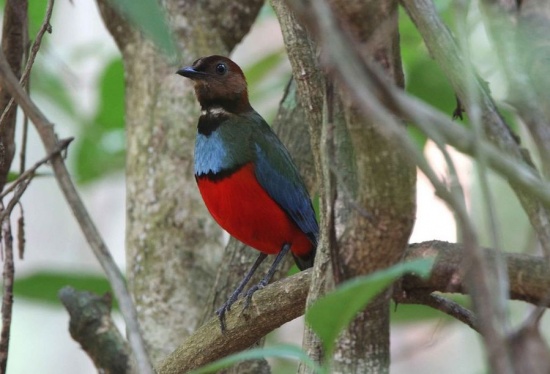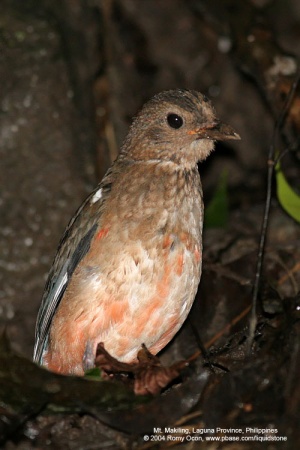| This article is incomplete. This article is missing one or more sections. You can help the BirdForum Opus by expanding it. |
- Pitta erythrogaster
Includes Sula Pitta
Identification
16 - 18cm. Wide geographical variation in plumage.
Nominate subspecies:
- Red-brown head with dark brown lores and supercilium and cinnamon cheeks
- Blue upper mantle
- Dark green lower mantle and back
- Blue rump and tail
- Deep blue upperwing-coverts, black flight-feathers, variable small white spots on primaries
- Black lower throat and upper breast (sometimes with white throatband)
- Broad glossy blue band across breast (variably becoming green at sides)
- Scarlet rest of underparts
- Black bill
Females are duller and more green and less blue on breast. Juveniles are dull brown above and have a dull blue rump and tail. They are paler below, have a whitish throat and a dark brown breast with white spots.
Distribution
Found on the Philippines, Sulawesi, the Moluccas, New Guinea (including Bismarck Archipelago) and northeast Australia (Cape York Peninsula).
Locally common in parts of its range.
Taxonomy
A large number of subspecies are recognized:
- P. e. erythrogaster on the Philippines (except Palawan)
- P. e. propinqua on Palawan and Balbac
- Brighter and slighty smaller than nominate
- P. e. caeruleitorques on Sangihe Island
- With a black band between blue breast and belly, brighter on nape, head more uniformely brown
- P. e. inspeculata on Talaud Islands
- With a dark chestnut-brown head, all blue upperparts and a smaller all blue breastband
- P. e. palliceps on Siao and Tahulandang, north of Sulawesi
- Similar to celbensis but paler, crown with less blue and no or little black on breast
- P. e. celebensis on Sulawesi (including Manterawu and Togian Islands)
- With blue stripe from midcrown to nape, more blue on breastband and broad black band below
- P. e. rufiventris on the northern Moluccas (Morotai, Halmahera, Moti, Bacan, Mandioli, Damar, Obi and possibly also Kasiruta)
- Reddish nape, dull dark green to dull blue rump, pale throat, no blue on mantle, thin black and greenish band below blue breast
- P. e. cyanonota on Ternate
- Bright rufous nape, dull blue upperpart, entire breast pale blue
- P. e. bernsteini on Gebe Island
- Similar to cyanonota but slightly bigger, paler above and blue on breast silvery
- P. e. rubrinucha on Buru
- P. e. piroensis
- P. e. mackloti
- P. e. habenichti
- P. e. aruensis
- P. e. oblita
- P. e. loriae
- P. e. extima
- P. e. novaehibernicae
- P. e. splendida
- P. e. gazellae
- P. e. finschii
- P. e. meeki
- P. e. dohertyi
Sula Pitta is recognised as a separate species (P. dohertyi) by Clements (2010), but is included as a subspecies of Red-bellied Pitta by Dickinson (2003) and Gill and Donsker (2010).
Placed in genus Erythropitta by Gill and Donsker[3].
Habitat
Subtropical or tropical moist lowland forests.
Behaviour
References
- Clements, JF. 2010. The Clements Checklist of Birds of the World. 6th ed., with updates to December 2010. Ithaca: Cornell Univ. Press. ISBN 978-0801445019. Spreadsheet available at http://www.birds.cornell.edu/clementschecklist/Clements%206.5.xls/view
- Dickinson, EC, ed. 2003. The Howard and Moore Complete Checklist of the Birds of the World. 3rd ed., with updates to October 2008 (Corrigenda 8). Princeton: Princeton Univ. Press. ISBN 978-0691117010
- Gill, F and D Donsker (Eds). 2010. IOC World Bird Names (version 2.7). Available at http://www.worldbirdnames.org/.
- Wikipedia
Recommended Citation
- BirdForum Opus contributors. (2024) Red-bellied Pitta. In: BirdForum, the forum for wild birds and birding. Retrieved 23 May 2024 from https://www.birdforum.net/opus/Red-bellied_Pitta





